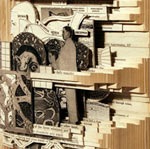 Brian Dettmer does terrible things to old books. He cuts off the covers, slices up the pages, and performs all sorts of mutilations, all in the name of art. The results are magnificent, like some sort of literary version of the Visible Man.
Brian Dettmer does terrible things to old books. He cuts off the covers, slices up the pages, and performs all sorts of mutilations, all in the name of art. The results are magnificent, like some sort of literary version of the Visible Man.
Category Archives: Pen and Link
Where the Wild Things Came From
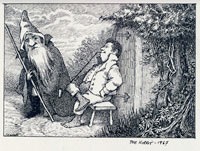 Slate Magazine has a nice online slideshow on the history of children’s books taken from Timothy G. Young’s new book, Drawn to Enchant. Once you get past the ad, there’s some nice trivia here, including a sketch from Maurice Sendak’s never-published version of The Hobbit.
Slate Magazine has a nice online slideshow on the history of children’s books taken from Timothy G. Young’s new book, Drawn to Enchant. Once you get past the ad, there’s some nice trivia here, including a sketch from Maurice Sendak’s never-published version of The Hobbit.
Writer’s and Illustrator’s Block
 I had a little bit of an epiphany today – nothing big, but helpful nonetheless. I’ve had Merlin Mann’s article on “Hacking Your Way Out of Writer’s Block” in my favorites for a long time, and I’ve been meaning to post a link. Merlin runs a great site called 43 Folders dedicated to making your work more efficient and getting things done.
I had a little bit of an epiphany today – nothing big, but helpful nonetheless. I’ve had Merlin Mann’s article on “Hacking Your Way Out of Writer’s Block” in my favorites for a long time, and I’ve been meaning to post a link. Merlin runs a great site called 43 Folders dedicated to making your work more efficient and getting things done.
Underwear and Medieval Literacy
 Did the wearing of underwear make people in the middle ages more literate? Don’t be ridiculous. Of course it did. Here’s why.
Did the wearing of underwear make people in the middle ages more literate? Don’t be ridiculous. Of course it did. Here’s why.
Lester Dent’s Pulp Fiction Master Plot
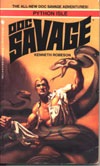 Lester Dent was a hugely prolific writer of mystery, western, and pulp fiction novels, the most famous being the Doc Savage series in the 1940’s-50’s. In this essay, he lays out the basic rules for constructing a rip-roaring, knockdown adventure story that will leave the reader reeling.
Lester Dent was a hugely prolific writer of mystery, western, and pulp fiction novels, the most famous being the Doc Savage series in the 1940’s-50’s. In this essay, he lays out the basic rules for constructing a rip-roaring, knockdown adventure story that will leave the reader reeling.
The ideas in the essay are great, but the best part is Dent’s prose; his teaching style is straight out of one of his novels. Here’s an excerpt, where he talks about building suspense and moving the plot along:
“Hero should accomplish something with his tearing around, if only to rescue Eloise, and surprise! Eloise is a ring-tailed monkey. The hero counts the rings on Eloise’s tail, if nothing better comes to mind. They’re not real. The rings are painted there. Why?”
Why indeed? Dynamite stuff!
Name That Color
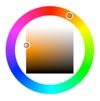
This little tool is surprisingly addictive. You can dial up a color on the big color wheel, and it tells you what it’s called. Ship Cove, Baltic Sea, Milk Punch – they’re all in there. Alternately, you can select a color by name and see what it looks like. The list was compiled from a number of a number of sources, including color-name dictionaries and Crayola.
SmudgeGuard
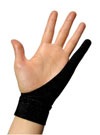 I first saw the SmudgeGuard mentioned on the internet a few months ago and thought I’d give it a try. The price was right, and I was getting really sick of using a paper mask to keep from smudging my drawings as I worked. (The fact that I’m left-handed only made things worse.)
I first saw the SmudgeGuard mentioned on the internet a few months ago and thought I’d give it a try. The price was right, and I was getting really sick of using a paper mask to keep from smudging my drawings as I worked. (The fact that I’m left-handed only made things worse.)
Now, having used the SmudgeGuard for a number of projects, I can say that I really like it. It’s well made, comfortable, comes in both left and right-hand versions, and does a great job of keeping my drawings clean. Plus, I look super-cool when I wear it. Recommended!
Drawing Little Orphan Annie
![]() Ted Slampyak, illustrator of the Little Orphan Annie comic strip has posted a great tutorial on how he organizes, prepares, and draws each daily installment. It’s full of great tips (he made a font of his own handwriting to speed things up) and strategies (make the word balloons first, then build the drawing around them). The only thing he doesn’t cover is how to draw pupils in eyeballs.
Ted Slampyak, illustrator of the Little Orphan Annie comic strip has posted a great tutorial on how he organizes, prepares, and draws each daily installment. It’s full of great tips (he made a font of his own handwriting to speed things up) and strategies (make the word balloons first, then build the drawing around them). The only thing he doesn’t cover is how to draw pupils in eyeballs.
How To Write a Book: The Short, Honest Truth
This short article by Scott Berkun does a really good job of cutting through the mystique of what it means to be an author. Want to write a book? Read this first.
Kuler
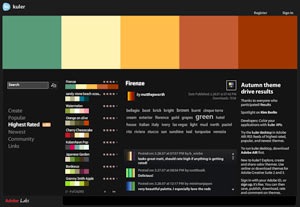
As an illustrator, color is one of the things I struggle with most. (Also, proportion, composition, coming up with good ideas, and keeping the ink off my clothes.) Adobe has recently put together a site called Kuler, and it’s purpose is to help people come up with pleasing color palettes.
3-D Pulp Covers
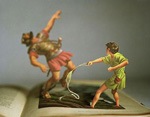 (Warning to librarians: the following link contains graphic images of book mutilation.)
(Warning to librarians: the following link contains graphic images of book mutilation.)
Thomas Allen cuts up books. Specifically, he cuts up the covers of old pulp novels, folds them back, and stages dioramas that bring a whole new life to the illustrations. These are a little hard to explain, but make perfect sense once you see his photos. Each one is a story unto itself.
Carved Crayons
Paperback Swap
 My friend and Auburn, NY librarian Anne Mlod recommended Paperback Swap to me. She loves it. The idea is simple: you post some of your books on the site, then search through the catalog for some that you want. Your only cost is basically the postage for mailing it out. Every book owner is responsible for mailing their books to whomever requests them, and the site even creates a wrapper you can print, complete with the address and postage pre-calculated.
My friend and Auburn, NY librarian Anne Mlod recommended Paperback Swap to me. She loves it. The idea is simple: you post some of your books on the site, then search through the catalog for some that you want. Your only cost is basically the postage for mailing it out. Every book owner is responsible for mailing their books to whomever requests them, and the site even creates a wrapper you can print, complete with the address and postage pre-calculated.
Tiny Writing
 For some reason – and I’m not sure I completely understand this – history is full of people driven to write as small as they possibly can. (And when I say small, I mean entire-bible-in-a-walnut small.) Cabinet Magazine features a great article on microscopic writing, covering everything from Sumerian stone carving to IBM’s precisely positioned xenon atoms.
For some reason – and I’m not sure I completely understand this – history is full of people driven to write as small as they possibly can. (And when I say small, I mean entire-bible-in-a-walnut small.) Cabinet Magazine features a great article on microscopic writing, covering everything from Sumerian stone carving to IBM’s precisely positioned xenon atoms.
Beautiful Dorena
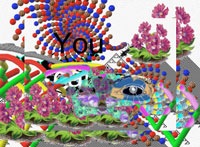 One of my rules in Pen and Link is that all software recommendations should be for both Windows and Mac. For Beautiful Dorena, I’m going to make an exception. This free, Mac-only painting program is so laugh-out-loud weird that I have to give it a mention.
One of my rules in Pen and Link is that all software recommendations should be for both Windows and Mac. For Beautiful Dorena, I’m going to make an exception. This free, Mac-only painting program is so laugh-out-loud weird that I have to give it a mention.
